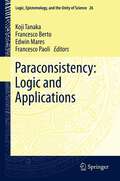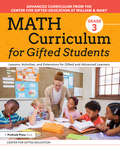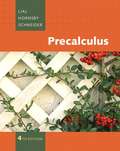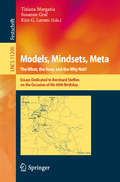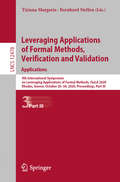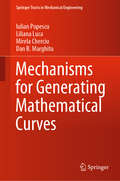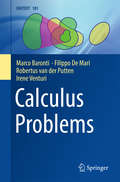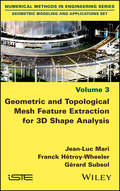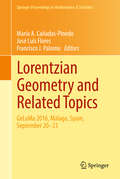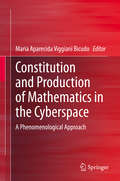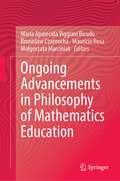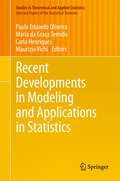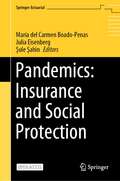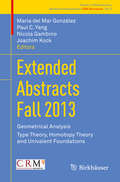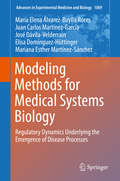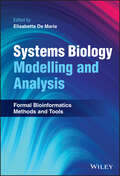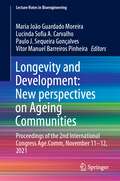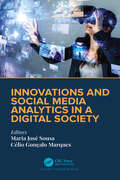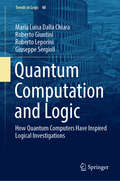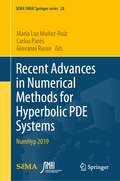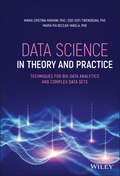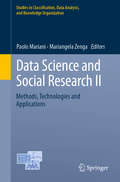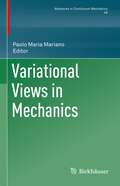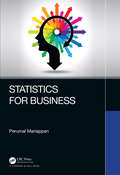- Table View
- List View
Paraconsistency: Logic and Applications
by Edwin Mares Francesco Berto Francesco Paoli Koji TanakaA logic is called 'paraconsistent' if it rejects the rule called 'ex contradictione quodlibet', according to which any conclusion follows from inconsistent premises. While logicians have proposed many technically developed paraconsistent logical systems and contemporary philosophers like Graham Priest have advanced the view that some contradictions can be true, and advocated a paraconsistent logic to deal with them, until recent times these systems have been little understood by philosophers. This book presents a comprehensive overview on paraconsistent logical systems to change this situation. The book includes almost every major author currently working in the field. The papers are on the cutting edge of the literature some of which discuss current debates and others present important new ideas. The editors have avoided papers about technical details of paraconsistent logic, but instead concentrated upon works that discuss more "big picture" ideas. Different treatments of paradoxes takes centre stage in many of the papers, but also there are several papers on how to interpret paraconistent logic and some on how it can be applied to philosophy of mathematics, the philosophy of language, and metaphysics.
Math Curriculum for Gifted Students: Lessons, Activities, and Extensions for Gifted and Advanced Learners: Grade 3
by Margaret Jess Mckowen PattiThe Math Curriculum for Gifted Students series:Provides gifted and advanced learners with challenging activities to extend their mathematical thinking.Includes lessons, activities, and extensions that are aligned to national standards.Is designed to provide high-ability learners advancement beyond the general curriculum.Is ideal for gifted classrooms or gifted pull-out groups.Was developed by the Center for Gifted Education at William & Mary.In Math Curriculum for Gifted Students (Grade 3), the 21 lessons cover mathematics content for grade 3 and are divided into five sections: number and operations in Base Ten, operations and algebraic thinking, number and operations-fractions, measurement and data, and geometry. Each lesson includes a teacher page that outlines the estimated time, key terms, materials, and objectives; a challenging activity to allow students to explore the concepts in depth; practice problems; and an assessment similar to standards-based grade-level standardized assessments.Optional Student Workbook PacksIn addition to this teacher's guide, companion student workbooks are available in sets of 5, which cover number/operations in Base Ten and operations/algebraic thinking (Grade 3
Precalculus
by Margaret L. Lial John Hornsby David I. Schneider Callie J. DanielsOver the years, the text has been shaped and adapted to meet the changing needs of both students and educators. As always, special care was taken to respond to the specific suggestions of users and reviewers through enhanced discussions, new and updated examples and exercises and helpful features. The result is an easy-to-use, comprehensive text that is the best edition yet.
Models, Mindsets, Meta: Essays Dedicated to Bernhard Steffen on the Occasion of His 60th Birthday (Lecture Notes in Computer Science #11200)
by Tiziana Margaria Susanne Graf Kim G. LarsenThis Festschrift volume is published in honor of Bernhard Steffen, Professor at the Technical University of Dortmund, on the occasion of his 60th birthday. His vision as well as his theoretical and practical work span the development and implementation of novel, specific algorithms, and the establishment of cross-community relationships with the effect to obtain simpler, yet more powerful solutions. He initiated many new lines of research through seminal papers that pioneered various fields, starting with the Concurrency Workbench, a model checking toolbox that significantly influenced the research and development of mode based high assurance systems worldwide. The contributions in this volume reflect the breadth and impact of his work. The introductory paper by the volume editors, the 23 full papers and two personal statements relate to Bernhard’s research and life. This volume, the talks and the entire B-Day at ISoLA 2018 are a tribute to the first 30 years of Bernhard’s passion, impact and vision for many facets of computer science in general and for formal methods in particular. Impact and vision include the many roles that formal methods-supported software development should play in education, in industry and in society.
Leveraging Applications of Formal Methods, Verification and Validation: 9th International Symposium on Leveraging Applications of Formal Methods, ISoLA 2020, Rhodes, Greece, October 20–30, 2020, Proceedings, Part III (Lecture Notes in Computer Science #12478)
by Tiziana Margaria Bernhard SteffenThe three-volume set LNCS 12476 - 12478 constitutes the refereed proceedings of the 9th International Symposium on Leveraging Applications of Formal Methods, ISoLA 2020, which was planned to take place during October 20–30, 2020, on Rhodes, Greece. The event itself was postponed to 2021 due to the COVID-19 pandemic. The papers presented were carefully reviewed and selected for inclusion in the proceedings. Each volume focusses on an individual topic with topical section headings within the volume:Part I, Verification Principles: Modularity and (De-)Composition in Verification; X-by-Construction: Correctness meets Probability; 30 Years of Statistical Model Checking; Verification and Validation of Concurrent and Distributed Systems. Part II, Engineering Principles: Automating Software Re-Engineering; Rigorous Engineering of Collective Adaptive Systems. Part III, Applications: Reliable Smart Contracts: State-of-the-art, Applications, Challenges and Future Directions; Automated Verification of Embedded Control Software; Formal methods for DIStributed COmputing in future RAILway systems.
Amazing Mathematicians - A Short eBook
by Charles MargerisonMathematics is the science of numbers. However, have you ever stopped to ask - who are the people behind the amazing formulas that have helped mankind find solutions to everyday probabilities? The Amazing People Club invites you to explore the exciting world of five amazing mathematicians. Their inspirational stories were not always about number crunching as we know it, as they strived in the search for 'truth' via theory. Gain an insight into how George Boole was inspired to combine logic with mathematics to reduce risks, developing calculations that although complex, enabled people to make better judgements. Immerse yourself in the life of Ada Lovelace, the "Enchantress of Numbers". Her intellect and skill in mathematics led to her developing a plan for calculating sequence, which is now recognized as the first computer program. Be inspired by the genius minds of Rene Descartes, Carl Gauss and Alan Turing, whose skills within mathematics, science and technology have formed the basis for how we still assess probabilities and find solutions to this very day. Each story comes to life through BioViews®. These are short biographical narratives, similar to interviews. They provide an easy way of learning about amazing people who made major contributions and changed our world.
Mechanisms for Generating Mathematical Curves (Springer Tracts in Mechanical Engineering)
by Dan B. Marghitu Iulian Popescu Liliana Luca Mirela CherciuThis book focuses on important mathematical considerations in describing the synthesis of original mechanisms for generating curves. The synthesis is manual and not based on the use of computer tools. Kinematics is applied to confirm the drawing of the curves, and the closed loop method, and in some cases the distances method, is applied in this phase. The book provides all the notions of structure and kinematics that are necessary to calculate the mechanisms and also analyzes other kinematic possibilities of the created mechanisms. Offering a concise, yet self-contained guide to the mathematical fundamentals for mechanisms of curve generation, together with a useful collection of mechanisms exercises, the book is intended for students learning about mechanism kinematics, as well as engineers dealing with mechanism design and analysis. It is based on the authors’ many years of research, which has been published in different books and journals, mainly, but not exclusively, in Romanian.
Calculus Problems (UNITEXT #101)
by Filippo Mari Marco Baronti Robertus Putten Irene VenturiThis book, intended as a practical working guide for students in Engineering, Mathematics, Physics, or any other field where rigorous calculus is needed, includes 450 exercises. Each chapter starts with a summary of the main definitions and results, which is followed by a selection of solved exercises accompanied by brief, illustrative comments. A selection of problems with indicated solutions rounds out each chapter. A final chapter explores problems that are not designed with a single issue in mind but instead call for the combination of a variety of techniques, rounding out the book's coverage. Though the book's primary focus is on functions of one real variable, basic ordinary differential equations (separation of variables, linear first order and constant coefficients ODEs) are also discussed. The material is taken from actual written tests that have been delivered at the Engineering School of the University of Genoa. Literally thousands of students have worked on these problems, ensuring their real-world applicability.
Geometric and Topological Mesh Feature Extraction for 3D Shape Analysis
by Jean-Luc Mari Franck Hétroy-Wheeler Gérard SubsolThree-dimensional surface meshes are the most common discrete representation of the exterior of a virtual shape. Extracting relevant geometric or topological features from them can simplify the way objects are looked at, help with their recognition, and facilitate description and categorization according to specific criteria. This book adopts the point of view of discrete mathematics, the aim of which is to propose discrete counterparts to concepts mathematically defined in continuous terms. It explains how standard geometric and topological notions of surfaces can be calculated and computed on a 3D surface mesh, as well as their use for shape analysis. Several applications are also detailed, demonstrating that each of them requires specific adjustments to fit with generic approaches. The book is intended not only for students, researchers and engineers in computer science and shape analysis, but also numerical geologists, anthropologists, biologists and other scientists looking for practical solutions to their shape analysis, understanding or recognition problems.
Lorentzian Geometry and Related Topics: Geloma 2016, Málaga, Spain, September 20-23 (Springer Proceedings In Mathematics And Statistics Series #211)
by María A. Cañadas-Pinedo José Luis Flores Francisco J. PalomoThis volume contains a collection of research papers and useful surveys by experts in the field which provide a representative picture of the current status of this fascinating area. Based on contributions from the VIII International Meeting on Lorentzian Geometry, held at the University of Málaga, Spain, this volume covers topics such as distinguished (maximal, trapped, null, spacelike, constant mean curvature, umbilical...) submanifolds, causal completion of spacetimes, stationary regions and horizons in spacetimes, solitons in semi-Riemannian manifolds, relation between Lorentzian and Finslerian geometries and the oscillator spacetime. In the last decades Lorentzian geometry has experienced a significant impulse, which has transformed it from just a mathematical tool for general relativity to a consolidated branch of differential geometry, interesting in and of itself. Nowadays, this field provides a framework where many different mathematical techniques arise with applications to multiple parts of mathematics and physics. This book is addressed to differential geometers, mathematical physicists and relativists, and graduate students interested in the field.
Constitution and Production of Mathematics in the Cyberspace: A Phenomenological Approach
by Maria Aparecida Viggiani BicudoThis book brings together various studies that assume phenomenology to analyze how mathematics education is affected by the experience of being in the cyberspace. The authors of the chapters included in this contributed volume work with the theoretical framework developed by authors such as Edmund Husserl, Martin Heidegger and Maurice Merleau-Ponty to investigate how mathematics is produced and comprehended in a new way of being in the world, with digital technologies. The aim of this book is not to explain the tools used and how one works with them in the cyberspace, aiming at better teaching and learning mathematics. Its purpose is to present philosophical investigations that contribute to the understanding of the complexity of the world in which we are being researchers and mathematics teachers. By doing so, Constitution and Production of Mathematics in the Cyberspace – A Phenomenological Approach will help researchers and mathematics teachers understand their role in a world in which the experience of teaching and learning mathematics is being radically changed by new technologies and new ways of being in this world.
Ongoing Advancements in Philosophy of Mathematics Education
by Maria Aparecida Viggiani Bicudo Bronislaw Czarnocha Maurício Rosa Małgorzata MarciniakOngoing Advancements in Philosophy of Mathematics Education approaches the philosophy of mathematics education in a forward movement, analyzing, reflecting, and proposing significant contemporary themes in the field of mathematics education. The theme that gives life to the book is philosophy of mathematics education understood as arising from the intertwining between philosophy of mathematics and philosophy of education which, through constant analytical and reflective work regarding teaching and learning practices in mathematics, is materialized in its own discipline, philosophy of mathematics education. This is the field of investigation of the chapters in the book. The chapters are written by an international cohort of authors, from a variety of countries, regions, and continents. Some of these authors work with philosophical and psychological foundations traditionally accepted by Western civilization. Others expose theoretical foundations based on a new vision and comprising innovative approaches to historical and present-day issues in educational philosophy. The final third of the book is devoted to these unique and innovative research stances towards important and change resistant societal topics such as racism, technology gaps, or the promotion of creativity in the field of mathematics education.
Recent Developments in Modeling and Applications in Statistics
by Maria da Graça Temido Paulo Eduardo Oliveira Carla Henriques Maurizio VichiStatistics has been a main tool in almost every field of activity and an essential part of applied scientific work, supporting conclusions and offering insights into new uses for established methodologies, thus making it a valuable resource in looking for faceless facts. Model construction describing populations or phenomena subject to randomness use a wide range of methods. Data collection provides the basis for modelling and assumption verification. Modelling must be conducted using suitable techniques that give researchers the means to search for hidden facts or behaviours. This may be addressed by fitting pre-defined shapes and distributions to the data or by allowing the data to reveal its intrinsic properties by using nonparametric methods. This volume contains a selection of contributions presented at the XVIII Annual Congress of the Portuguese Statistical Society.
Pandemics: Insurance and Social Protection (Springer Actuarial)
by María del Carmen Boado-Penas Julia Eisenberg Şule ŞahinThis open access book collects expert contributions on actuarial modelling and related topics, from machine learning to legal aspects, and reflects on possible insurance designs during an epidemic/pandemic.Starting by considering the impulse given by COVID-19 to the insurance industry and to actuarial research, the text covers compartment models, mortality changes during a pandemic, risk-sharing in the presence of low probability events, group testing, compositional data analysis for detecting data inconsistencies, behaviouristic aspects in fighting a pandemic, and insurers’ legal problems, amongst others.Concluding with an essay by a practicing actuary on the applicability of the methods proposed, this interdisciplinary book is aimed at actuaries as well as readers with a background in mathematics, economics, statistics, finance, epidemiology, or sociology.
Extended Abstracts Fall 2013
by Maria del Mar González Paul C. Yang Nicola Gambino Joachim KockThe two parts of the present volume contain extended conference abstracts corresponding to selected talks given by participants at the "Conference on Geometric Analysis" (thirteen abstracts) and at the "Conference on Type Theory, Homotopy Theory and Univalent Foundations" (seven abstracts), both held at the Centre de Recerca Matemàtica (CRM) in Barcelona from July 1st to 5th, 2013, and from September 23th to 27th, 2013, respectively. Most of them are brief articles, containing preliminary presentations of new results not yet published in regular research journals. The articles are the result of a direct collaboration between active researchers in the area after working in a dynamic and productive atmosphere. The first part is about Geometric Analysis and Conformal Geometry; this modern field lies at the intersection of many branches of mathematics (Riemannian, Conformal, Complex or Algebraic Geometry, Calculus of Variations, PDE's, etc) and relates directly to the physical world, since many natural phenomena posses an intrinsic geometric content. The second part is about Type Theory, Homotopy Theory and Univalent Foundations. The book is intended for established researchers, as well as for PhD and postdoctoral students who want to learn more about the latest advances in these highly active areas of research.
Modeling Methods for Medical Systems Biology: Regulatory Dynamics Underlying the Emergence of Disease Processes (Advances in Experimental Medicine and Biology #1069)
by María Elena Álvarez-Buylla Roces Juan Carlos Martínez-García José Dávila-Velderrain Elisa Domínguez-Hüttinger Mariana Esther Martínez-SánchezThis book contributes to better understand how lifestyle modulations can effectively halt the emergence and progression of human diseases. The book will allow the reader to gain a better understanding of the mechanisms by which the environment interferes with the bio-molecular regulatory processes underlying the emergence and progression of complex diseases, such as cancer. Focusing on key and early cellular bio-molecular events giving rise to the emergence of degenerative chronic disease, it builds on previous experience on the development of multi-cellular organisms, to propose a mathematical and computer based framework that allows the reader to analyze the complex interplay between bio-molecular processes and the (micro)-environment from an integrative, mechanistic, quantitative and dynamical perspective. Taking the wealth of empirical evidence that exists it will show how to build and analyze models of core regulatory networks involved in the emergence and progression of chronic degenerative diseases, using a bottom-up approach.
Systems Biology Modelling and Analysis: Formal Bioinformatics Methods and Tools
by Elisabetta De MariaSystems Biology Modelling and Analysis Describes important modelling and computational methods for systems biology research to enable practitioners to select and use the most suitable technique Systems Biology Modelling and Analysis provides an overview of state-of-the-art techniques and introduces related tools and practices to formalize models and automate reasoning for systems biology. The authors present and compare the main formal methods used in systems biology for modelling biological networks, including discussion of their advantages, drawbacks, and main applications. Each chapter includes an intuitive presentation of the specific formalism, a brief history of the formalism and of its applications in systems biology, a formal description of the formalism and its variants, at least one realistic case study, some applications of formal techniques to validate and make deep analysis of models encoded with the formalism, and a discussion on the kind of biological systems for which the formalism is suited, along with concrete ideas on its possible evolution. Edited by a highly qualified expert with significant experience in the field, some of the methods and techniques covered in Systems Biology Modelling and Analysis include: Petri nets, an important tool for studying different aspects of biological systems, ranging from simple signaling pathways to metabolic networks and beyond Pathway Logic, a formal, rule-based system and interactive viewer for developing executable models of cellular processes Boolean networks, a mathematical model which has been widely used for decades in the context of biological regulation networks Answer Set Programming (ASP), which has proven to be a strong logic programming paradigm to deal with the inherent complexity of biological models For systems biologists, biochemists, bioinformaticians, molecular biologists, pharmacologists, and computer scientists, Systems Biology Modelling and Analysis is a comprehensive all-in-one resource to understand and harness the field’s current models and techniques while also preparing for their potential developments in coming years with the help of the author’s expert insight.
Longevity and Development: Proceedings of the 2nd International Congress Age.Comm, November 11–12, 2021 (Lecture Notes in Bioengineering)
by Maria João Guardado Moreira Lucinda Sofia A. Carvalho Paulo J. Sequeira Gonçalves Vítor Manuel Barreiros PinheiraThis book focuses on the dynamic process of aging and on interventions to support the development of older and integrated societies, from a multidisciplinary point of view. Gathering contributions from researchers and professionals with different backgrounds, including social and health sciences, education, engineering and IT, biology, geography and environmental science, it aims at understanding the phenomenon of population aging, in order to contribute to the development of future functional communities, fostering well-being and autonomy of the elderly, their integration and participation. Based on the proceedings of the 2nd International Congress Age.Comm Longevity and Development, organised online on November 11-12, 2021, from Castelo Branco, Portugal, this book addresses a wide range of specialists dealing with the process of aging, integration and community development in the societies of the future.
Innovations and Social Media Analytics in a Digital Society
by Maria José Sousa and Célio Gonçalo MarquesRecent advances in digitization are transforming healthcare, education, tourism, information technology, and some other sectors. Social media analytics are tools that can be used to measure innovation and the relation of the companies with the citizens. This book comprises state-ofthe-art social media analytics, and advanced innovation policies in the digitization of society. The number of applications that can be used to create and analyze social media analytics generates large amounts of data called big data, including measures of the use of the technologies to develop or to use new services to improve the quality of life of the citizens. Digitization has applications in fields from remote monitoring to smart sensors and other devices. Integration generates data that need to be analyzed and visualized in an easy and clear way, that will be some of the proposals of the researchers present in this book. This volume offers valuable insights to researchers on how to design innovative digital analytics systems and how to improve information delivery remotely.
Quantum Computation and Logic: How Quantum Computers Have Inspired Logical Investigations (Trends in Logic #48)
by Maria Luisa Dalla Chiara Roberto Giuntini Roberto Leporini Giuseppe SergioliThis book provides a general survey of the main concepts, questions and results that have been developed in the recent interactions between quantum information, quantum computation and logic. Divided into 10 chapters, the books starts with an introduction of the main concepts of the quantum-theoretic formalism used in quantum information. It then gives a synthetic presentation of the main “mathematical characters” of the quantum computational game: qubits, quregisters, mixtures of quregisters, quantum logical gates. Next, the book investigates the puzzling entanglement-phenomena and logically analyses the Einstein–Podolsky–Rosen paradox and introduces the reader to quantum computational logics, and new forms of quantum logic. The middle chapters investigate the possibility of a quantum computational semantics for a language that can express sentences like “Alice knows that everybody knows that she is pretty”, explore the mathematical concept of quantum Turing machine, and illustrate some characteristic examples that arise in the framework of musical languages. The book concludes with an analysis of recent discussions, and contains a Mathematical Appendix which is a survey of the definitions of all main mathematical concepts used in the book.
Recent Advances in Numerical Methods for Hyperbolic PDE Systems: NumHyp 2019 (SEMA SIMAI Springer Series #28)
by María Luz Muñoz-Ruiz Carlos Parés Giovanni RussoThe present volume contains selected papers issued from the sixth edition of the International Conference "Numerical methods for hyperbolic problems" that took place in 2019 in Málaga (Spain). NumHyp conferences, which began in 2009, focus on recent developments and new directions in the field of numerical methods for hyperbolic partial differential equations (PDEs) and their applications. The 11 chapters of the book cover several state-of-the-art numerical techniques and applications, including the design of numerical methods with good properties (well-balanced, asymptotic-preserving, high-order accurate, domain invariant preserving, uncertainty quantification, etc.), applications to models issued from different fields (Euler equations of gas dynamics, Navier-Stokes equations, multilayer shallow-water systems, ideal magnetohydrodynamics or fluid models to simulate multiphase flow, sediment transport, turbulent deflagrations, etc.), and the development of new nonlinear dispersive shallow-water models. The volume is addressed to PhD students and researchers in Applied Mathematics, Fluid Mechanics, or Engineering whose investigation focuses on or uses numerical methods for hyperbolic systems. It may also be a useful tool for practitioners who look for state-of-the-art methods for flow simulation.
Data Science in Theory and Practice: Techniques for Big Data Analytics and Complex Data Sets
by Maria Cristina Mariani Osei Kofi Tweneboah Maria Pia Beccar-VarelaDATA SCIENCE IN THEORY AND PRACTICE EXPLORE THE FOUNDATIONS OF DATA SCIENCE WITH THIS INSIGHTFUL NEW RESOURCE Data Science in Theory and Practice delivers a comprehensive treatment of the mathematical and statistical models useful for analyzing data sets arising in various disciplines, like banking, finance, health care, bioinformatics, security, education, and social services. Written in five parts, the book examines some of the most commonly used and fundamental mathematical and statistical concepts that form the basis of data science. The authors go on to analyze various data transformation techniques useful for extracting information from raw data, long memory behavior, and predictive modeling. The book offers readers a multitude of topics all relevant to the analysis of complex data sets. Along with a robust exploration of the theory underpinning data science, it contains numerous applications to specific and practical problems. The book also provides examples of code algorithms in R and Python and provides pseudo-algorithms to port the code to any other language. Ideal for students and practitioners without a strong background in data science, readers will also learn from topics like: Analyses of foundational theoretical subjects, including the history of data science, matrix algebra and random vectors, and multivariate analysis A comprehensive examination of time series forecasting, including the different components of time series and transformations to achieve stationarity Introductions to both the R and Python programming languages, including basic data types and sample manipulations for both languages An exploration of algorithms, including how to write one and how to perform an asymptotic analysis A comprehensive discussion of several techniques for analyzing and predicting complex data sets Perfect for advanced undergraduate and graduate students in Data Science, Business Analytics, and Statistics programs, Data Science in Theory and Practice will also earn a place in the libraries of practicing data scientists, data and business analysts, and statisticians in the private sector, government, and academia.
Data Science and Social Research II: Methods, Technologies and Applications (Studies in Classification, Data Analysis, and Knowledge Organization)
by Paolo Mariani Mariangela ZengaThe peer-reviewed contributions gathered in this book address methods, software and applications of statistics and data science in the social sciences. The data revolution in social science research has not only produced new business models, but has also provided policymakers with better decision-making support tools. In this volume, statisticians, computer scientists and experts on social research discuss the opportunities and challenges of the social data revolution in order to pave the way for addressing new research problems. The respective contributions focus on complex social systems and current methodological advances in extracting social knowledge from large data sets, as well as modern social research on human behavior and society using large data sets. Moreover, they analyze integrated systems designed to take advantage of new social data sources, and discuss quality-related issues. The papers were originally presented at the 2nd International Conference on Data Science and Social Research, held in Milan, Italy, on February 4-5, 2019.
Variational Views in Mechanics (Advances in Mechanics and Mathematics #46)
by Paolo Maria MarianoThis volume provides a timely survey of interactions between the calculus of variations and theoretical and applied mechanics. Chapters have been significantly expanded since preliminary versions appeared in a special issue of the Journal of Optimization Theory and Applications (184(1), 2020) on “Calculus of Variations in Mechanics and Related Fields”. The variety of topics covered offers researchers an overview of problems in mechanics that can be analyzed with variational techniques, making this a valuable reference for researchers in the field. It also presents ideas for possible future areas of research, showing how the mastery of these foundational mathematical techniques can be used for many exciting applications. Specific topics covered include:Topology optimizationIdentification of material propertiesOptimal controlPlastic flowsGradient polyconvexityObstacle problemsQuasi-monotonicity Variational Views in Mechanics will appeal to researchers in mathematics, solid-states physics, and mechanical, civil, and materials engineering.
Statistics for Business
by Perumal MariappanStatistics for Business is meant as a textbook for students in business, computer science, bioengineering, environmental technology, and mathematics. In recent years, business statistics is used widely for decision making in business endeavours. It emphasizes statistical applications, statistical model building, and determining the manual solution methods. Special Features: This text is prepared based on "self-taught" method. For most of the methods, the required algorithm is clearly explained using flow-charting methodology. More than 200 solved problems provided. More than 175 end-of-chapter exercises with answers are provided. This allows teachers ample flexibility in adopting the textbook to their individual class plans. This textbook is meant to for beginners and advanced learners as a text in Statistics for Business or Applied Statistics for undergraduate and graduate students.
